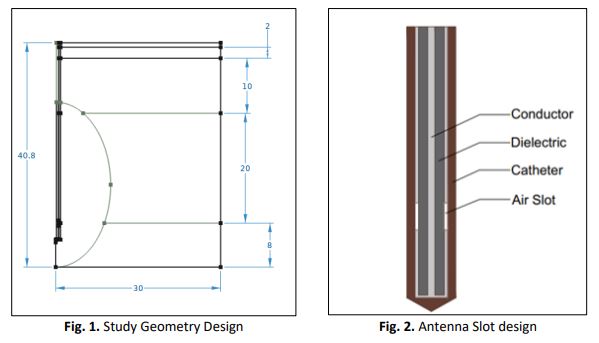Effect of Blood Perfusion on Temperature Distribution in the Multilayer of the Human Body with Interstitial Hyperthermia Treatment for Tumour Therapy
DOI:
https://doi.org/10.37934/cfdl.14.6.102114Keywords:
Bioheat transfer, blood perfusion, interstitial hyperthermia therapy, unsteady, finite element methodAbstract
Blood perfusion is defined as the volume of blood flowing through units of tissue volume per second. In thermoregulation, blood perfusion is a factor that affects heat transfer in the body, the greater the rate of blood perfusion will complicate the distribution of temperature throughout the body. In the study of bioheat transfer, heat transfer in the human body can be used as a therapy. At therapeutic temperatures (above 40°C), cells will die and stop their growth or commonly called hyperthermia therapy. It can allow thermonecrosis in body tissues and can be useful for tumour tissue. Of the various types of hyperthermia therapy, interstitial hyperthermia therapy is considered more effective because heat is directly delivered to tumour tissue to minimize other tissues exposed to therapeutic temperatures. Currently, there are no studies that study the effect of blood perfusion on the treatment of interstitial hyperthermia, even though blood perfusion greatly affects the temperature distribution in the human body/ In this study, heat transfer analysis will be performed on five layers of the human body, namely the epidermis, dermis, fat, muscle, and bones with interstitial application of hyperthermia therapy and affected by blood perfusion with a value of (8x10-4; 4x10-4; 2x10-4; 1x10-3; and 2x10-3)/s completed using finite element method with unsteady conditions in two axial dimensions. The part of the tumour studied is a tumour in the arm (forearm) in the span of 600s. This study shows that blood perfusion affects the value of temperature distribution in five layers of the body in unsteady conditions. The greater the value of blood perfusion flowing in the body, the more difficult the temperature will be to transmit because the blood distributes heat throughout the body faster, the difference between blood perfusion values is quite significant.
Downloads
References
Dymling, Stephan O., Hans W. Persson, and C. Hellmuth Hertz. "Measurement of blood perfusion in tissue using Doppler ultrasound." Ultrasound in Medicine & Biology 17, no. 5 (1991): 433-444. https://doi.org/10.1016/0301-5629(91)90179-Z
Ricketts, Patricia L., Ashvinikumar V. Mudaliar, Brent E. Ellis, Clay A. Pullins, Leah A. Meyers, Otto I. Lanz, Elaine P. Scott, and Thomas E. Diller. "Non-invasive blood perfusion measurements using a combined temperature and heat flux surface probe." International Journal of Heat and Mass Transfer 51, no. 23-24 (2008): 5740-5748. https://doi.org/10.1016/j.ijheatmasstransfer.2008.04.051
Luitel, Kabita, Dil Bahadur Gurung, and Kedar Nath Uprety. "Effect of various parameters for temperature distribution in human body: An analytic approach." Advances in Science, Technology and Engineering Systems Journal, Special issue on Recent Advances in Engineering Systems Journal 3, no. 5 (2018): 421-426. https://doi.org/10.25046/aj030548
Shirkavand, Abolfazl, and Hamid Reza Nazif. "Numerical study on the effects of blood perfusion and body metabolism on the temperature profile of human forearm in hyperthermia conditions." Journal of Thermal Biology 84 (2019): 339-350. https://doi.org/10.1016/j.jtherbio.2019.07.023
Abidin, Mohamad Naufal Zainal, and Md Yushalify Misro. "Numerical Simulation of Heat Transfer using Finite Element Method." Journal of Advanced Research in Fluid Mechanics and Thermal Sciences 92, no. 2 (2022): 104-115. https://doi.org/10.37934/arfmts.92.2.104115
Pennes, Harry H. "Analysis of tissue and arterial blood temperatures in the resting human forearm." Journal of Applied Physiology 1, no. 2 (1948): 93-122. https://doi.org/10.1152/jappl.1948.1.2.93
Tansey, Etain A., and Christopher D. Johnson. "Recent advances in thermoregulation." Advances in Physiology Education 39, no. 3 (2015): 139-148. https://doi.org/10.1152/advan.00126.2014
Siauve, Nicolas, and Corine Lormel. "Interstitial microwave hyperthermia treatment investigations." In Journal of Physics: Conference Series, vol. 395, no. 1, p. 012001. IOP Publishing, 2012. https://doi.org/10.1088/1742-6596/395/1/012001
Gas, Piotr. "Temperature Distribution of Human Tissue in Interstitial Microwave Hyperthermia." Przeglad Elektrotechniczny 88, no. 7a (2012): 144-146.
Gozal, Fenny, and H. M. Djakaria. "Sarkoma Ewing." Radioterapi & Onkologi Indonesia 8, no. 1 (2017): 39-49. https://doi.org/10.32532/jori.v8i1.58
Haghniaz, Reihaneh, Rinku D. Umrani, and Kishore M. Paknikar. "Hyperthermia Mediated by Dextran-Coated La 0.7 Sr 0.3 MnO 3 Nanoparticles: In vivo Studies [Corrigendum]." International Journal of Nanomedicine 17 (2022): 1481-1482. https://doi.org/10.2147/IJN.S365531
Barnoon, Pouya, and Mahdi Ashkiyan. "Magnetic field generation due to the microwaves by an antenna connected to a power supply to destroy damaged tissue in the liver considering heat control." Journal of Magnetism and Magnetic Materials 513 (2020): 167245. https://doi.org/10.1016/j.jmmm.2020.167245
Lv, Yong-Gang, and Jing Liu. "Effect of transient temperature on thermoreceptor response and thermal sensation." Building and Environment 42, no. 2 (2007): 656-664. https://doi.org/10.1016/j.buildenv.2005.10.030
Sharma, Kal Renganathan. Transport Phenomena in Biomedical Engineering: Artifical organ Design and Development, and Tissue Engineering. McGraw-Hill Education, 2010.
Gabriel, Camelia. Compilation of the dielectric properties of body tissues at RF and microwave frequencies. King's Coll London (United Kingdom) Dept of Physics, 1996. https://doi.org/10.21236/ADA303903
Gas, Piotr. "Transient analysis of interstitial microwave hyperthermia using multi-slot coaxial antenna." In Analysis and Simulation of Electrical and Computer Systems, pp. 63-71. Springer, Cham, 2015. https://doi.org/10.1007/978-3-319-11248-0_5




























